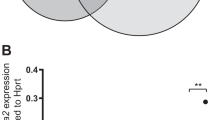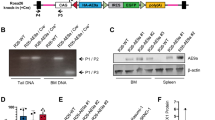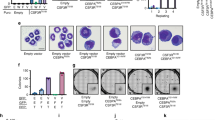Abstract
Biallelic CEBPA mutations and FMS-like tyrosine kinase receptor 3 (FLT3) length mutations are frequently identified in human acute myeloid leukemia (AML) with normal cytogenetics. However, the molecular and cellular mechanisms of oncogene cooperation remain unclear because of a lack of disease models. We have generated an AML mouse model using knockin mouse strains to study cooperation of an internal tandem duplication (ITD) mutation in the Flt3 gene with commonly observed CCAAT/enhancer binding protein alpha (C/EBPα) mutations. This study provides evidence that FLT3 ITD cooperates in leukemogenesis by enhancing the generation of leukemia-initiating granulocyte-monocyte progenitors (GMPs) otherwise prevented by a block in differentiation and skewed lineage priming induced by biallelic C/EBPα mutations. These cellular changes are accompanied by an upregulation of hematopoietic stem cell and STAT5 target genes. By gene expression analysis in premalignant populations, we further show a role of FLT3 ITD in activating genes involved in survival/transformation and chemoresistance. Both multipotent progenitors and GMP cells contain the potential to induce AML similar to corresponding cells in human AML samples showing that this model resembles human disease.
This is a preview of subscription content, access via your institution
Access options
Subscribe to this journal
Receive 12 print issues and online access
$259.00 per year
only $21.58 per issue
Buy this article
- Purchase on Springer Link
- Instant access to full article PDF
Prices may be subject to local taxes which are calculated during checkout






Similar content being viewed by others
Abbreviations
- 3:
-
GMP
References
Rosenbauer F, Tenen DG . Transcription factors in myeloid development: balancing differentiation with transformation. Nat Rev Immunol 2007; 7: 105–117.
Tenen DG . Disruption of differentiation in human cancer: AML shows the way. Nat Rev Cancer 2003; 3: 89–101.
Renneville A, Roumier C, Biggio V, Nibourel O, Boissel N, Fenaux P et al. Cooperating gene mutations in acute myeloid leukemia: a review of the literature. Leukemia 2008; 22: 915–931.
Gilliland DG . Hematologic malignancies. Curr Opin Hematol 2001; 8: 189–191.
Green CL, Koo KK, Hills RK, Burnett AK, Linch DC, Gale RE . Prognostic significance of CEBPA mutations in a large cohort of younger adult patients with acute myeloid leukemia: impact of double CEBPA mutations and the interaction with FLT3 and NPM1 mutations. J Clin Oncol 2010; 28: 2739–2747.
Frohling S, Schlenk RF, Stolze I, Bihlmayr J, Benner A, Kreitmeier S et al. CEBPA mutations in younger adults with acute myeloid leukemia and normal cytogenetics: prognostic relevance and analysis of cooperating mutations. J Clin Oncol 2004; 22: 624–633.
Koschmieder S, Halmos B, Levantini E, Tenen DG . Dysregulation of the C/EBPalpha differentiation pathway in human cancer. J Clin Oncol 2009; 27: 619–628.
Zhang P, Iwasaki-Arai J, Iwasaki H, Fenyus ML, Dayaram T, Owens BM et al. Enhancement of hematopoietic stem cell repopulating capacity and self-renewal in the absence of the transcription factor C/EBP alpha. Immunity 2004; 21: 853–863.
Heath V, Suh HC, Holman M, Renn K, Gooya JM, Parkin S et al. C/EBPalpha deficiency results in hyperproliferation of hematopoietic progenitor cells and disrupts macrophage development in vitro and in vivo. Blood 2004; 104: 1639–1647.
Nerlov C . C/EBPalpha mutations in acute myeloid leukaemias. Nat Rev Cancer 2004; 4: 394–400.
Bereshchenko O, Mancini E, Moore S, Bilbao D, Mansson R, Luc S et al. Hematopoietic stem cell expansion precedes the generation of committed myeloid leukemia-initiating cells in C/EBPalpha mutant AML. Cancer Cell 2009; 16: 390–400.
Marcucci G, Haferlach T, Döhner H . Molecular genetics of adult acute myeloid leukemia: prognostic and therapeutic implications. J Clin Oncol 2011; 29: 475–486.
Takahashi S . Current findings for recurring mutations in acute myeloid leukemia. J Hematol Oncol 2011; 4: 36.
Lee BH, Tothova Z, Levine RL, Anderson K, Buza-Vidas N, Cullen DE et al. FLT3 mutations confer enhanced proliferation and survival properties to multipotent progenitors in a murine model of chronic myelomonocytic leukemia. Cancer Cell 2007; 12: 367–380.
Li L, Piloto O, Nguyen HB, Greenberg K, Takamiya K, Racke F et al. Knock-in of an internal tandem duplication mutation into murine FLT3 confers myeloproliferative disease in a mouse model. Blood 2008; 111: 3849–3858.
Taskesen E, Bullinger L, Corbacioglu A, Sanders MA, Erpelinck CA, Wouters BJ et al. Prognostic impact, concurrent genetic mutations, and gene expression features of AML with CEBPA mutations in a cohort of 1182 cytogenetically normal AML patients: further evidence for CEBPA double mutant AML as a distinctive disease entity. Blood 2011; 117: 2469–2475.
Wouters BJ, Lowenberg B, Erpelinck-Verschueren CA, van Putten WL, Valk PJ, Delwel R . Double CEBPA mutations, but not single CEBPA mutations, define a subgroup of acute myeloid leukemia with a distinctive gene expression profile that is uniquely associated with a favorable outcome. Blood 2009; 113: 3088–3091.
Kirstetter P, Schuster MB, Bereshchenko O, Moore S, Dvinge H, Kurz E et al. Modeling of C/EBPalpha mutant acute myeloid leukemia reveals a common expression signature of committed myeloid leukemia-initiating cells. Cancer Cell 2008; 13: 299–310.
Pronk CJ, Rossi DJ, Mansson R, Attema JL, Norddahl GL, Chan CK et al. Elucidation of the phenotypic, functional, and molecular topography of a myeloerythroid progenitor cell hierarchy. Cell Stem Cell 2007; 1: 428–442.
Pabst T, Eyholzer M, Fos J, Mueller BU . Heterogeneity within AML with CEBPA mutations; only CEBPA double mutations, but not single CEBPA mutations are associated with favourable prognosis. Br J Cancer 2009; 100: 1343–1346.
Radomska HS, Basseres DS, Zheng R, Zhang P, Dayaram T, Yamamoto Y et al. Block of C/EBP alpha function by phosphorylation in acute myeloid leukemia with FLT3 activating mutations. J Exp Med 2006; 203: 371–381.
Reckzeh K, Cammenga J . Molecular mechanisms underlying deregulation of C/EBPalpha in acute myeloid leukemia. Int J Hematol 2010; 91: 557–568.
Kato N, Kitaura J, Doki N, Komeno Y, Watanabe-Okochi N, Togami K et al. Two types of C/EBP {alpha} mutations play distinct but collaborative roles in leukemogenesis: lessons from clinical data and BMT models. Blood 2010; 117: 221–233.
Soh J, Okumura N, Lockwood WW, Yamamoto H, Shigematsu H, Zhang W et al. Oncogene mutations, copy number gains and mutant allele specific imbalance (MASI) frequently occur together in tumor cells. PLoS One 2009; 4: e7464.
Choudhary C, Olsen JV, Brandts C, Cox J, Reddy PN, Bohmer FD et al. Mislocalized activation of oncogenic RTKs switches downstream signaling outcomes. Mol Cell 2009; 36: 326–339.
Schmidt-Arras DE, Bohmer A, Markova B, Choudhary C, Serve H, Bohmer FD . Tyrosine phosphorylation regulates maturation of receptor tyrosine kinases. Mol Cell Biol 2005; 25: 3690–3703.
Kiel MJ, Yilmaz OH, Iwashita T, Terhorst C, Morrison SJ . SLAM family receptors distinguish hematopoietic stem and progenitor cells and reveal endothelial niches for stem cells. Cell 2005; 121: 1109–1121.
Mansson R, Hultquist A, Luc S, Yang L, Anderson K, Kharazi S et al. Molecular evidence for hierarchical transcriptional lineage priming in fetal and adult stem cells and multipotent progenitors. Immunity 2007; 26: 407–419.
Choudhary C, Brandts C, Schwable J, Tickenbrock L, Sargin B, Ueker A et al. Activation mechanisms of STAT5 by oncogenic Flt3-ITD. Blood 2007; 110: 370–374.
Hayakawa F, Towatari M, Kiyoi H, Tanimoto M, Kitamura T, Saito H et al. Tandem-duplicated Flt3 constitutively activates STAT5 and MAP kinase and introduces autonomous cell growth in IL-3-dependent cell lines. Oncogene 2000; 19: 624–631.
Kelly LM, Liu Q, Kutok JL, Williams IR, Boulton CL, Gilliland DG . A constitutively activated mutant FLT3 causes a myeloproliferative disease in mice. Blood 2001; 98: 469a–469a.
Smith LL, Yeung J, Zeisig BB, Popov N, Huijbers I, Barnes J et al. Functional crosstalk between Bmi1 and MLL/Hoxa9 Axis in establishment of normal hematopoietic and leukemic stem cells. Cell Stem Cell 2011; 8: 649–662.
Opferman JT, Iwasaki H, Ong CC, Suh H, Mizuno S-I, Akashi K et al. Obligate role of anti-apoptotic MCL-1 in the survival of hematopoietic stem cells. Science 2005; 307: 1101–1104.
Craig RW . MCL1 provides a window on the role of the BCL2 family in cell proliferation, differentiation and tumorigenesis. Leukemia 2002; 16: 444–454.
Wuilleme-Toumi S, Robillard N, Gomez P, Moreau P, Le Gouill S, Avet-Loiseau H et al. Mcl-1 is overexpressed in multiple myeloma and associated with relapse and shorter survival. Leukemia 2005; 19: 1248–1252.
Wertz IE, Kusam S, Lam C, Okamoto T, Sandoval W, Anderson DJ et al. Sensitivity to antitubulin chemotherapeutics is regulated by MCL1 and FBW7. Nature 2011; 471: 110–114.
Yoshimoto G, Miyamoto T, Jabbarzadeh-Tabrizi S, Iino T, Rocnik JL, Kikushige Y et al. FLT3-ITD up-regulates MCL-1 to promote survival of stem cells in acute myeloid leukemia via FLT3-ITD-specific STAT5 activation. Blood 2009; 114: 5034–5043.
Krivtsov AV, Twomey D, Feng Z, Stubbs MC, Wang Y, Faber J et al. Transformation from committed progenitor to leukaemia stem cell initiated by MLL-AF9. Nature 2006; 442: 818–822.
Li Z, Dullmann J, Schiedlmeier B, Schmidt M, von Kalle C, Meyer J et al. Murine leukemia induced by retroviral gene marking. Science 2002; 296: 497.
Boiers C, Buza-Vidas N, Jensen CT, Pronk CJ, Kharazi S, Wittmann L et al. Expression and role of FLT3 in regulation of the earliest stage of normal granulocyte-monocyte progenitor development. Blood 2010; 115: 5061–5068.
Yang L, Bryder D, Adolfsson J, Nygren J, Månsson R, Sigvardsson M et al. Identification of Lin–Sca1+kit+CD34+Flt3– short-term hematopoietic stem cells capable of rapidly reconstituting and rescuing myeloablated transplant recipients. Blood 2005; 105: 2717–2723.
Taussig DC, Miraki-Moud F, Anjos-Afonso F, Pearce DJ, Allen K, Ridler C et al. Anti-CD38 antibody-mediated clearance of human repopulating cells masks the heterogeneity of leukemia-initiating cells. Blood 2008; 112: 568–575.
Somervaille TC, Cleary ML . Identification and characterization of leukemia stem cells in murine MLL-AF9 acute myeloid leukemia. Cancer Cell 2006; 10: 257–268.
Goardon N, Marchi E, Atzberger A, Quek L, Schuh A, Soneji S et al. Coexistence of LMPP-like and GMP-like leukemia stem cells in acute myeloid leukemia. Cancer Cell 2011; 19: 138–152.
Acknowledgements
We gratefully thank Pekka Jaako and Zhi Ma for assistance with FACS and Garry Gilliland for making the Flt3ITD/+ mice available. This work was supported by grants from the Swedish Research Council (#K2007-64X-20412-01-3) through Hemato-Linne, Linneaus center of excellence grant, avtal om läkarutbildning och forskning (ALF) from Skåne University Hospital, Crafoordska Stiftelse, John Persson Stiftelse, Gunnar Nilssons Cancerstiftelse, Georg Danielssons Forskningsfond, Åke-Wiberg Stiftelse, Siv-Inger och Per-Erik Anderssons Minnesfond, Barncancerfonden and Forsknings- och utvecklingsenheten (FoU) to Jörg Cammenga and an MRC Program Grant to Claus Nerlov (Grant number 93339).
Author information
Authors and Affiliations
Corresponding author
Ethics declarations
Competing interests
The authors declare no conflict of interest.
Additional information
Supplementary Information accompanies the paper on the Leukemia website
Rights and permissions
About this article
Cite this article
Reckzeh, K., Bereshchenko, O., Mead, A. et al. Molecular and cellular effects of oncogene cooperation in a genetically accurate AML mouse model. Leukemia 26, 1527–1536 (2012). https://doi.org/10.1038/leu.2012.37
Received:
Revised:
Accepted:
Published:
Issue Date:
DOI: https://doi.org/10.1038/leu.2012.37
Keywords
This article is cited by
-
Elucidating disease-associated mechanisms triggered by pollutants via the epigenetic landscape using large-scale ChIP-Seq data
Epigenetics & Chromatin (2023)
-
Targeting C/EBPα overcomes primary resistance and improves the efficacy of FLT3 inhibitors in acute myeloid leukaemia
Nature Communications (2023)
-
C/EBPα deregulation as a paradigm for leukemogenesis
Leukemia (2017)
-
The multifaceted functions of C/EBPα in normal and malignant haematopoiesis
Leukemia (2016)
-
C/EBPα in normal and malignant myelopoiesis
International Journal of Hematology (2015)



